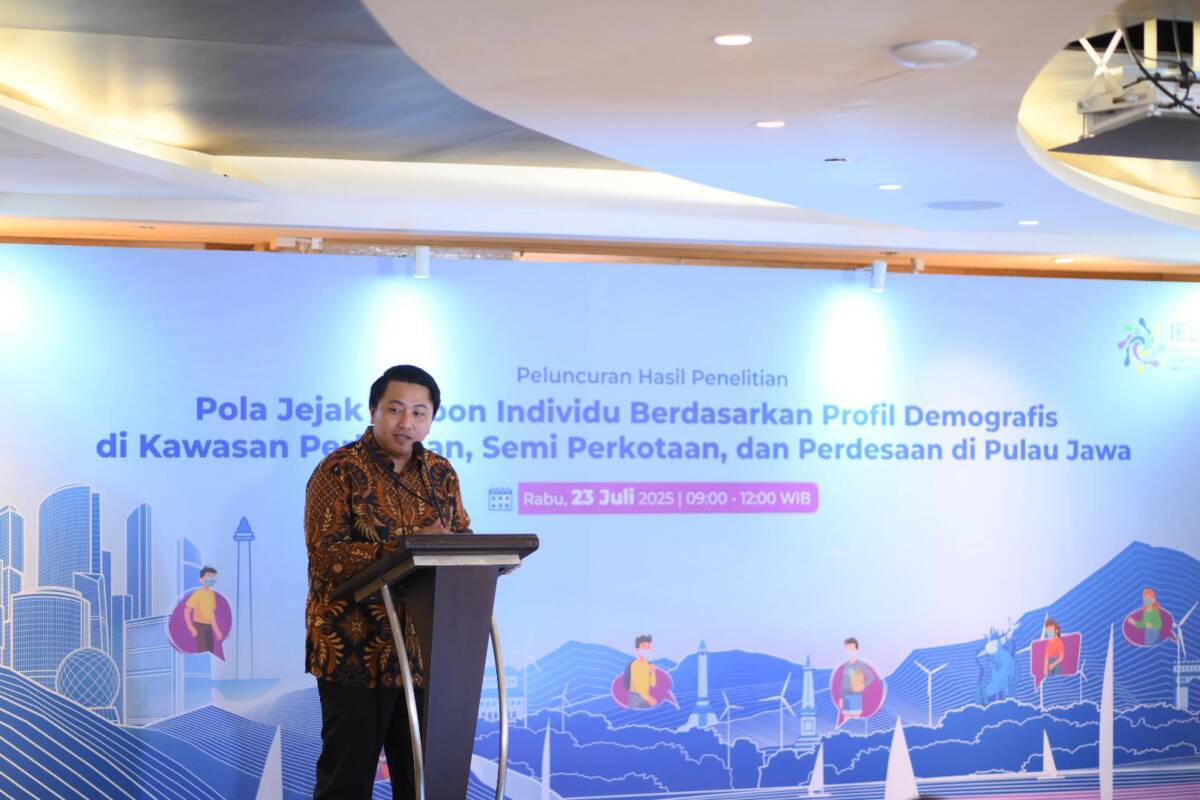Jakarta, July 23, 2025 – Human activities are the primary contributors to the increase in atmospheric carbon emissions. These emissions are driving the climate crisis, leading to a rise in hydrometeorological disasters. 2024 was a record-breaking year with the hottest average temperature, reaching 1.47 degrees Celsius above pre-industrial average temperatures.
The Institute for Essential Services Reform (IESR) has conducted a study on total individual greenhouse gas (GHG) emissions, or carbon footprints, in urban, semi-urban, and rural areas across Java Island to identify patterns and influencing factors. The study found that urban areas generate higher total emissions per individual compared to semi-urban and rural areas. The average total individual emissions in urban areas reached 3.4 tons of carbon dioxide equivalent per year. Absorbing this amount of carbon would require approximately 25 trees maintained for 20 years.
Deon Arinaldo, Manager of Energy System Transformation, IESR mentioned that to calculate individual carbon footprints, IESR developed the platform Jejakkarbonku.id, which has been used by 76,000 visitors as of 2025. Deon emphasized that collective awareness of individual carbon footprints can drive efforts to reduce emissions, while also creating demand for low-emission products and services.
“High individual emissions in urban areas originate from the transportation, food, and household sectors. This information is crucial for helping the government and other stakeholders design appropriate strategies, such as implementing integrated policies in the transportation sector,” Deon stated at the launch of the study, “Individual Carbon Footprint Patterns Based on Demographic Profiles in Urban, Semi-Urban, and Rural Areas on Java Island.”
The IESR study was conducted in nine areas representing urban, semi-urban, and rural characteristics: South Jakarta City, Bandung, and Yogyakarta (urban); Bogor City, Cirebon, and Serang (semi-urban); and Purworejo Regency, Banjarnegara, and Cianjur (rural). The total population in these nine areas is 11.7 million people, while the number of respondents in this study was 483. The study results show that individual emissions in urban areas reached 3.39 tons of carbon dioxide equivalent per capita per year. This figure is higher compared to semi-urban areas at 2.81 tons and rural areas at 2.33 tons of carbon dioxide equivalent per capita per year.
Irwan Sarifudin, Coordinator of the Clean Energy Hub, IESR, explained that generally there are three main sectors contributing significantly to total emissions per individual on Java Island are transportation (43.34%), food (34.91%), and households (21.08%). High emissions from the transportation sector reflect the dominance of private vehicle use, limited efficient public transportation, and increased mobility in urban areas. Meanwhile, the consumption of processed foods and animal products contributes high emissions due to their production and distribution processes. On the other hand, emissions from the household sector come from the use of electricity and fuels like Liquefied Petroleum Gas (LPG) for domestic needs.
“Generally, groups with higher income and consumption levels contribute more to GHG emissions due to intensive consumption patterns, private vehicle use, and high energy consumption. However, the impact of these emissions is felt more acutely by communities with limited access to healthcare and social protection, and who are more vulnerable to the risks of climate change,” Irwan explained.
IESR recommends two strategies to reduce carbon emissions in urban, semi-urban, and rural areas. First, focus on reducing emissions in the transportation sector. In urban areas, the government can develop environmentally friendly transportation infrastructure through the integration of transport modes, expansion of bicycle lanes, and the addition of public electric vehicle charging stations. For semi-urban areas, the government needs to expand public transportation access connecting city centers with buffer zones and build integrated parking facilities. Furthermore, in rural areas, the government needs to provide incentives for electric motorcycles. These efforts must be accompanied by the development of charging facilities and improved access to public transportation to support sustainable mobility.
Second, the government can provide incentives or subsidies for households that switch to efficient electronic devices such as LED lamps and inverters. Other support can include the installation of solar panels through flexible financing schemes. In the food sector, educational campaigns and collaboration with producers need to be carried out to encourage the consumption of low-emission foods and ensure their availability and affordability.

